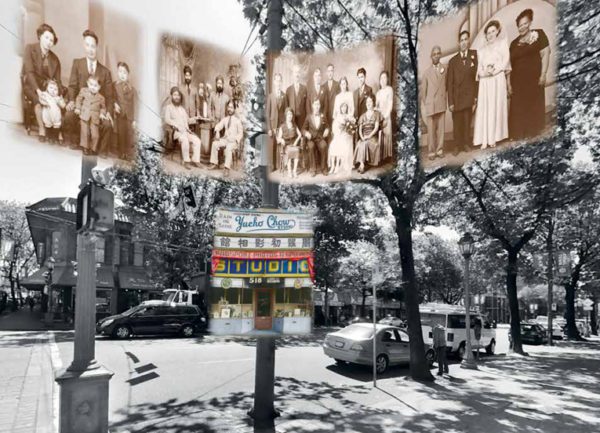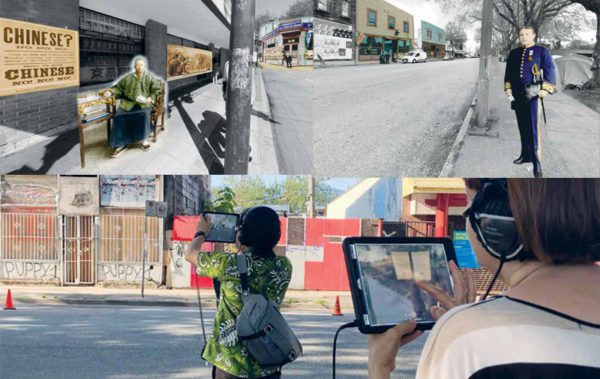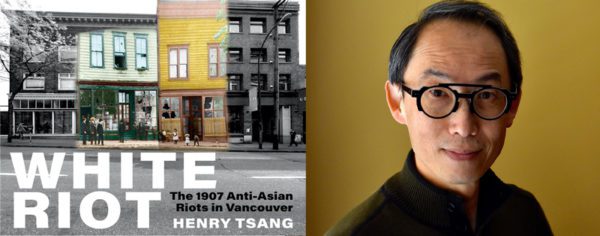
Westminster Avenue and Dupont Street, Main and Pender (360 Riot Walk)
Several projects led multidisciplinary artist Henry Tsang to his first book, White Riot: The 1907 Anti-Asian Riots in Vancouver, published this month by Arsenal Pulp Press. Among these was 2018’s RIOT FOOD HERE, his pop-up food stand series that addressed Vancouver’s anti-Asian upheaval more than a century earlier. The program featured tastings of period-inspired fare and began with a walking tour of Vancouver, led by author Michael Barnholden, that traced the route of the riots that sprang from the Asiatic Exclusion League–backed anti-immigration parade and demonstration in 1907.
“It was during this event when the thought entered my mind: What if this tour was available as a self-guided experience? And what if it was interactive, with archival imagery to accompany the information and insight that Michael was providing – and site specific?” Tsang explains in White Riot. “What if it was a 360 video experience that blended the here, the now, and the past? And so I came up with the idea for what would become 360 Riot Walk.”
Launched in 2019, the interactive 360-degree video tour revisits sites that were vital to the local Asian Canadian population at the time, and tracks the path of the anti-Asian mob. Archival images are superimposed on contemporary streetscapes to situate historic events in modern locations.

Clockwise from top left: East Pender Street and Columbia Street, northwest corner (360 Riot Walk); Powell Street Grounds, Oppenheimer Park (360 Riot Walk); 360 Riot Walk guided tour participants, 2019 (Henry Tsang)
White Riot is an extension of 360 Riot Walk. In addition to the material from the enhanced tour and its digital platform, the book also contains pictures and texts by academics and activists that relate the atmosphere surrounding this dark moment in Vancouver’s history and its lingering shadows.
Unlike electronic media, the printed page is not subject to technological change. Creating the book, Tsang notes, offered longevity. “We set up the website for the project and I was commissioning some writers to do little pieces,” he says from his home in Vancouver. “And then I started thinking about a book as a way to expand and contextualize it, as well as [provide] a different kind of legacy for the project.”
From September 7 to 9, 1907, the mob that emerged from the thousands of protesters stormed the Chinatown and Powell Street neighbourhoods, intimidating residents and destroying property, in a siege fuelled by the era’s socially and politically sanctioned hostility toward racialized groups. White Riot, however, is more than a history lesson. “Anyone reading the book gets a real insight into the complexities of race – particularly as it affects Asian people here in Vancouver – because it is a very complex thing and racism is, on one hand, a very easy thing to define,” says Brian Lam, publisher of Arsenal Pulp Press. “But I think what Henry’s book does is that it explores those complexities in a very nuanced way.”
Arsenal Pulp Press is located in the same Chinatown where the book is set, and Lam says the community-mindedness of the area remains intact. This is echoed by the range of voices and perspectives included in White Riot, from the heartfelt to the mobilizing. The contributed pieces supplement Tsang’s own content and reflect Chinese- and Japanese-Canadian issues, in addition to considering the South Asian community impacted by the era’s exclusionary measures.

Henry Tsang (Emiko Morita)
Parallels between past and present, of course, are unavoidable. White Riot arrives amid the resurgence of anti-Asian violence stoked by the pandemic. Underscoring the book is a “sense of community and working together. Certainly not an ‘us versus them’ kind of thing,” Lam says, “this is something that affects all of us.”
According to Tsang, the volume carries a message about societal inequities. “Not just Asian Canadian specific, but being able to just say this is part of our history – our collective history – and we need to be aware of all the different histories that people have experienced,” he says. “And to question the official ones that have supported a certain kind of power structure or status quo or master narrative.”
 Contact us via email
Contact us via email

